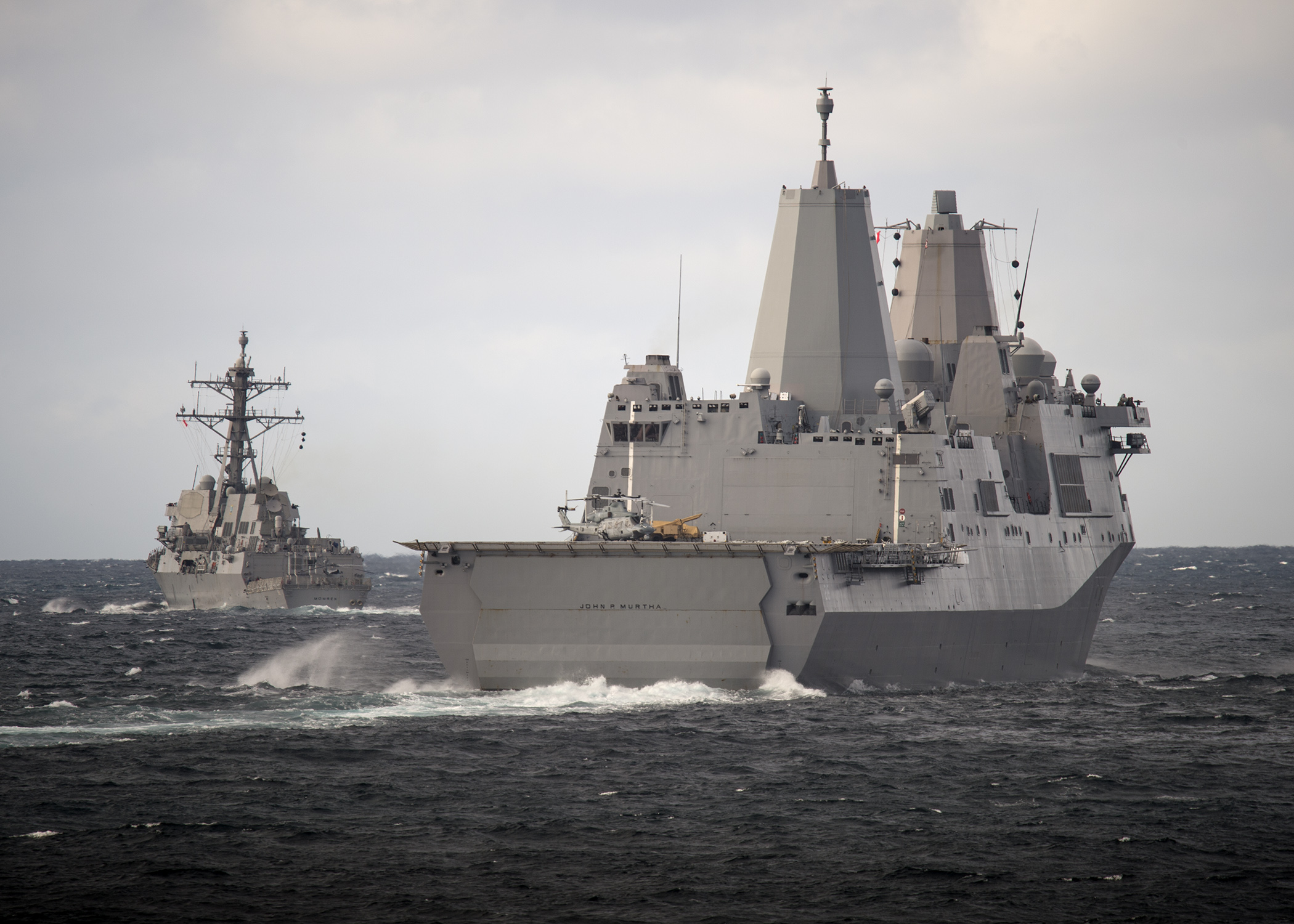
WASHINGTON, D.C. — The Navy’s third Virginia-class attack submarine in the Fiscal Year 2020 budget request comes at the expense of beginning the LPD Flight II amphibious warship program on time, top leadership said.
The LPD Flight II program, which will replace the fleet’s aging Whidbey Island-class dock landing ships (LSD-41/49) with an iteration of the much more capable San Antonio-class amphibious transport dock, was supposed to start with the lead ship in 2020 and then go into serial production in 2022. Instead, the FY 2020 budget request released this week shows a single ship in 2021 and a single ship in 2023.
“Through the lens of the National Defense Strategy’s focus on great power competition, the Navy prioritized the offensive capabilities of other ship classes, including an additional Virginia-class submarine and an additional Arleigh Burke-class destroyer over an LPD Flight II,” Navy spokeswoman Lt. Lauren Chatmas told USNI News.
Noting that the most recent force structure assessment calls for 38 amphibious warships, including a total of 26 Flight I and Flight II LPDs, she added, “the FY20 shipbuilding plan procures one LPD in FY21 and one LPD in FY23. With this adjustment, Navy’s requirement for 26 LPDs is met in FY40. Overall, Navy’s amphibious force is healthy, hovering within 10 percent or less of its requirement of 38 ships throughout the shipbuilding plan.”
Chief of Naval Operations Adm. John Richardson told reporters Wednesday that the shipbuilding plan, as adjusted by this year’s budget request, “will get to 36, which is pretty close to the requirement for 38. So if you want to think about the LPD, what we did there was we have an SSN there in (FY 2020) where the LPD was. We’re much further away from our warfighter requirement in SSNs than we are in amphibs, so that was just a warfighting priority.”
The Navy has 51 attack submarines today compared to the FSA requirement of 66, according to the Naval Vessel Register. It has 32 amphibious warships compared to a requirement of 38.
For the Marine Corps, though, the Navy’s requirement of 38 amphibs has long been viewed as a floor, or a minimum need, rather than a goal. Commandant of the Marine Corps Gen. Robert Neller acknowledged Wednesday that the Pentagon had to balance joint force needs in its budget request, but he added that the Marines needed more amphibs to train and conduct their missions and that he would take his pitch to Congress.
“If you look across the globe, everybody else seems to be growing their amphibious capability, buying ships, building ships. So I think there is great utility, but again, everything else (in the Pentagon budget) has got to compete; we’ve got to show value and how we fit within these concepts. At some point you’ve got to get somewhere, you’ve got to have something big enough and survivable enough to get there,” he said in a speech at the annual McAleese Defense Programs event.
“I think (amphibious shipping) has great utility, but it’s up to us to make the case to the Congress and the American people that it is an important capability.”
Chairman of the Joint Chiefs of Staff Gen. Joseph Dunford today in the first congressional hearing on the FY 2020 budget request began to make that case in front of the Senate Armed Services Committee. Asked what role the LPDs would have in a fight against China, for example, Dunford told the committee that “it’s critical for us to be able to project power in the context of China. One of the traditional missions of the Marine Corps is seizing advanced naval bases, and if you look at the island chains and so forth in the Pacific as platforms from which we can project power, that would be a historical mission the Marine Corps has and one that is very relevant in a China scenario.”
Neller said Wednesday that the National Defense Strategy guiding this year’s budget focuses on the Indo-Pacific region, which is a maritime theater.
“We understand we have to compete against other capabilities, and obviously we would like to see particularly the LPD Flight II moved to the left, where it was, and I’ll continue to articulate that and do my best to express that to (House Armed Services seapower and projection forces subcommittee Chairman Joe) Courtney and Rep. (Rob) Wittman and others on the committee to try to do that. But there’s trades, and I’ve always prided myself – I’m a member of the Joint Chiefs, but I’m also the commandant, so I have to be what I call operationally intellectually honest. And so I’ve got to be able to make the case that, to move those to the left or to increase the number of amphibs is a better value for your dollar than buying something else,” he said.
“We have a Marine Corps to come from the sea, and I can’t come from the sea if I don’t have a way to get underway. So we’ll work through that. I will, at the appropriate time, express my opinion on that.”





